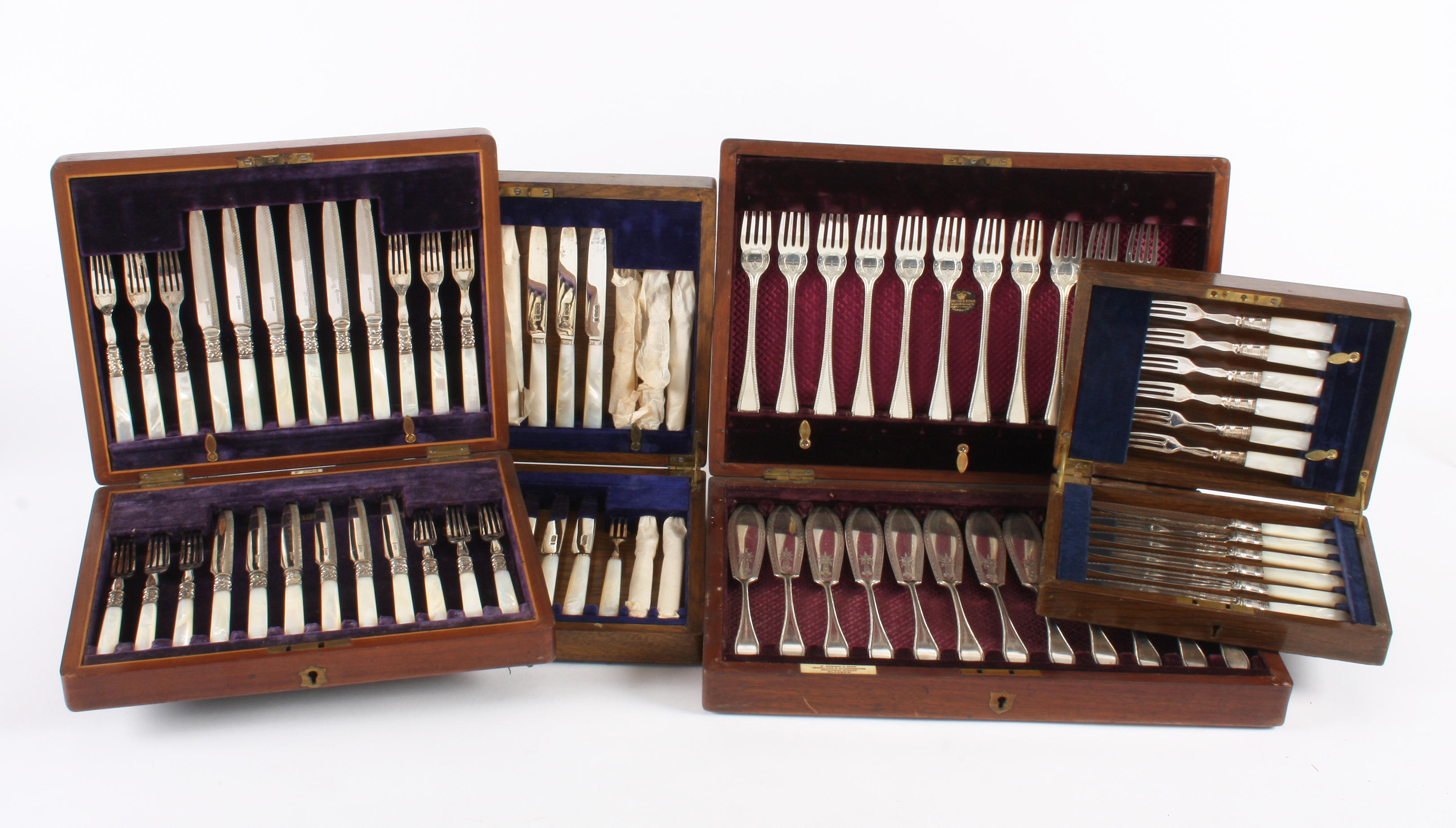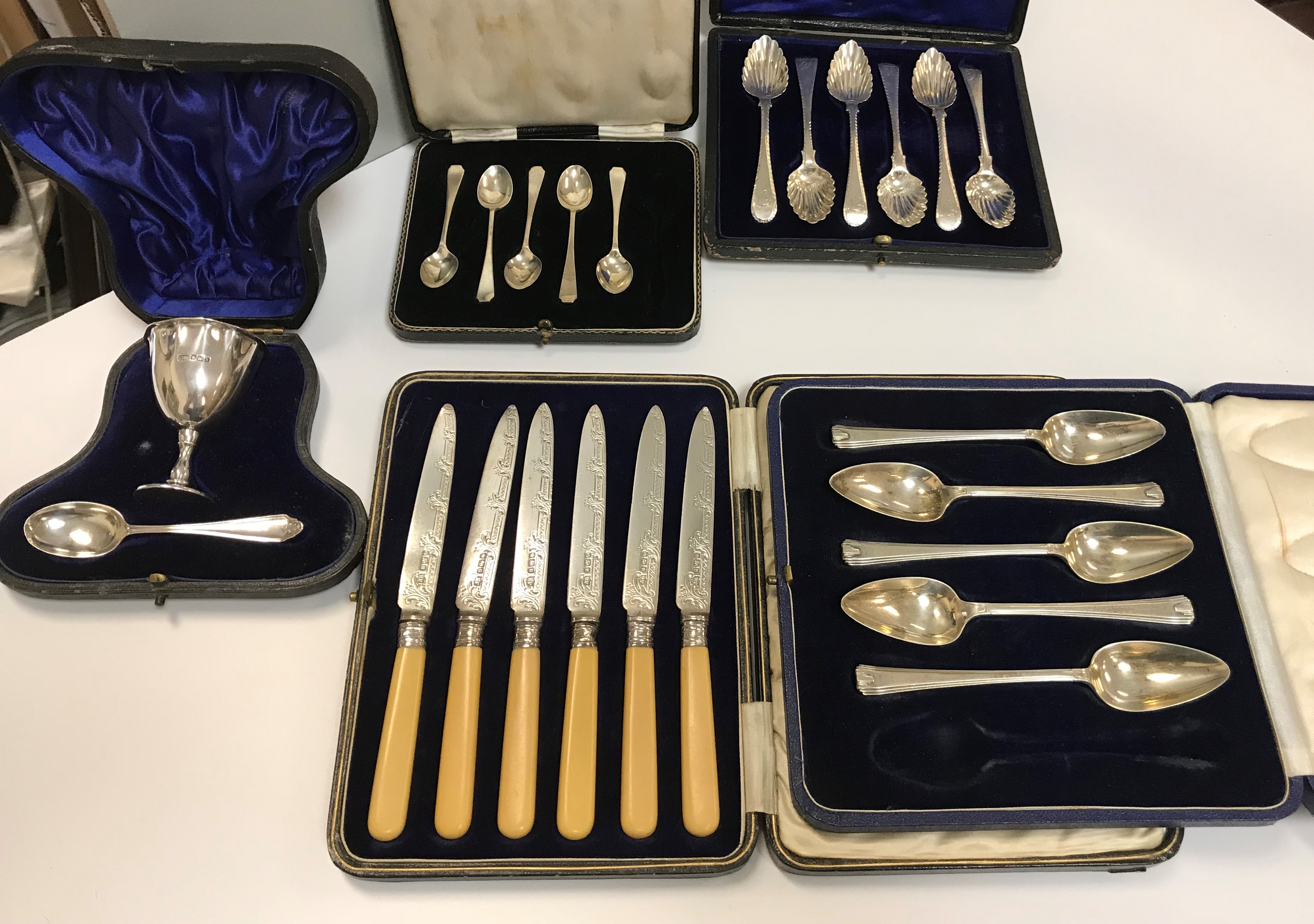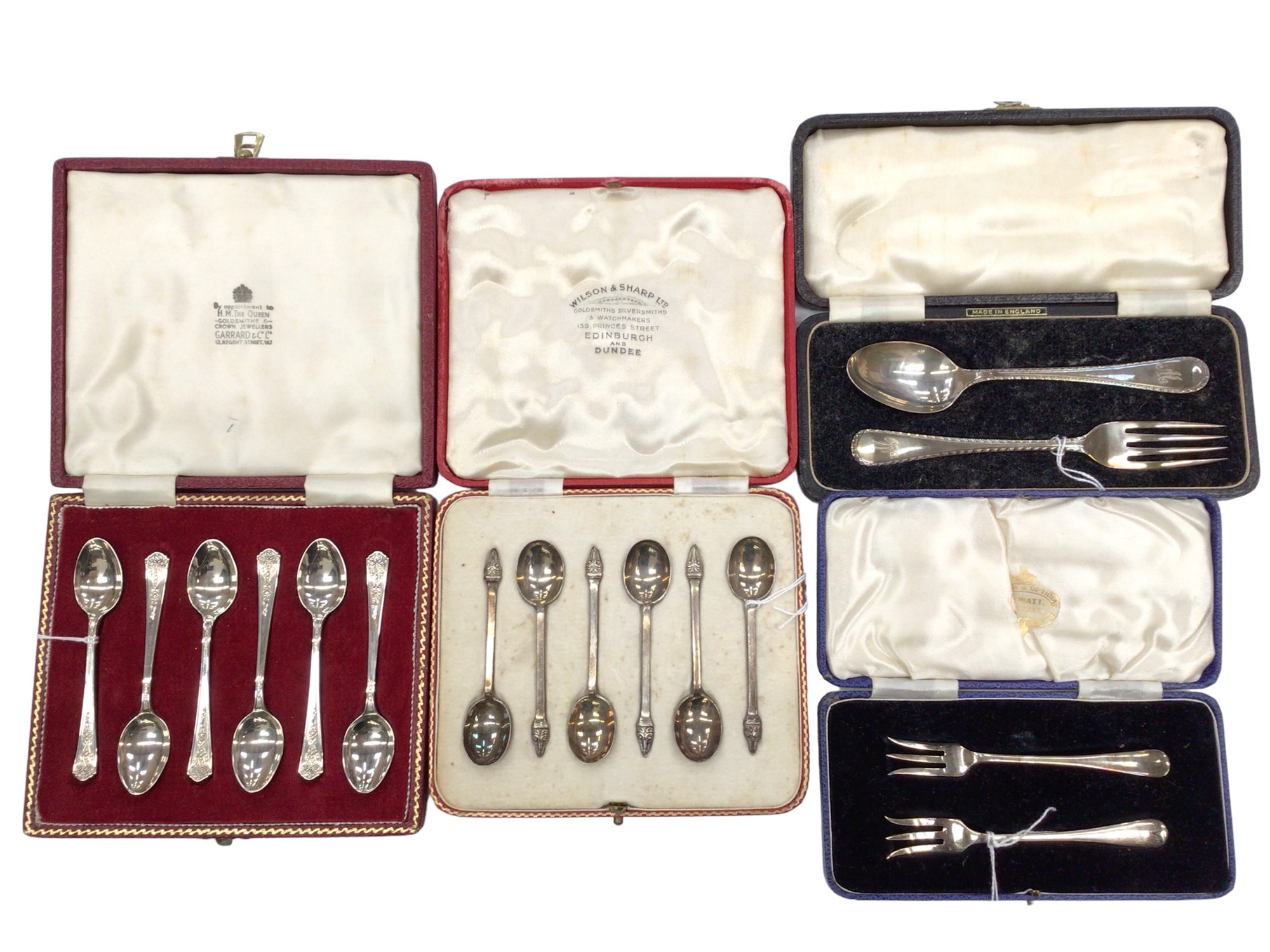comprising knife struck with maker?s details, crown dividing the royal initials ?GR?, and ?Shear steel', natural staghorn grip, and nickel silver pommel, fork and steel en suite in its leatherette case lined in blue with the maker?s detail inside the lid in gilt letters; the second, T. Glossop, Sheffield, similar, in its mahogany case, the first case 41.5 cm (2) Literature David Hayden-Wright, The Heritage of English Knives, Atglen, Pennsylvania, 2008, p. 192. In the nineteenth century, Rodgers had an unsurpassed reputation and history that was synonymous with the cutlery trade. The family's first cutler, John Rodgers (1701-85), is recorded around 1724, with a workshop near the present cathedral. In the same year the Company of Cutlers 'let' him a mark, a Star and Maltese Cross, which became world famous in later years. John Rodgers had three sons, John (1731-1811), Joseph (1743-1821), and Maurice (c.1747-1824) who joined the business and succeeded him. They are recorded with more workshops by 1780 and the business soon extended to occupy a nearby block of buildings at 6 Norfolk Street, an address that became as famous as Rodgers? trade mark. By the early 19th century their trade had expanded from pen and pocket knives to include table cutlery and scissors. By 1817 the General Sheffield Directory lists the firm as ?merchants, factors, table and pocket knife, and razor manufacturers?. In 1821 John?s son Joseph died and his sons continued the business under the leadership of the younger John (grandson of the founder). John was described as ?unobtrusive in his manner? but was ambitious and one of the founding partners of the Sheffield Banking Co. He had a flair for marketing and travelled the country taking orders. Not only was his firm?s output and range greater than any other Sheffield firm, but its quality was superior. The company?s manifesto states: ?The principle on which the manufacture of cutlery is carried on by this firm is ? quality first ? [and] ? price comes second?. He began making exhibitions knives and presented George IV with a minute specimen of cutlery with 57 blades, which occupied only an inch [25mm] when closed. In 1822, Rodgers? was awarded its first Royal Warrant. Another fourteen royal appointments, from British and overseas royal dignitaries, followed over the next eighty years, and its company history was duly titled: Under Five Sovereigns. John Rodgers next commissioned the Year Knife, with a blade for every year (1821) and opened his sensational cutlery showroom in Norfolk Street where visitors came to marvel at Rodgers? creations. Perhaps the greatest highlight shown there was the Norfolk Knife, an over 30 inch long sportsman?s knife with 75 blades and tools, that Rodgers? produced for the Great Exhibition in 1851. The showroom proved particularly popular with Americans whose trade played a significant role in the firm?s expansion. Additionally, they looked East, with agents in Calcutta, Bombay, and Hong Kong by the mid-19th century. These markets enabled Rodgers to become the largest cutlery factory in Sheffield. The number of workmen appears to have grown from about 300 in the late 1820s, to over 500 in the 1840s. In 1871 the business became a limited company with Joseph Rodgers (1828-1883), grandson of the Joseph Rodgers who had died in 1821 and Robert Newbold as managing directors. Joseph died on 12 May 1883 and Newbold became the chairman and managing director. The firm continued to expand with offices in London, New York, New Orleans, Montreal, Toronto, Calcutta, Bombay and Havana. Their work force in 1871 was around 1,200 and accounted for one-seventh of all Sheffield?s American cutlery trade. In 1876 the American market was stagnating and Rodgers? began looking elsewhere with a focus on trade in the Middle East, India and Australia. Notably the name ?Rujjus? or ?Rojers? was said to have entered the language as an adjective expressing superb quality in Persia, India and Ceylon. By 1888,
comprising knife struck with maker?s details, crown dividing the royal initials ?GR?, and ?Shear steel', natural staghorn grip, and nickel silver pommel, fork and steel en suite in its leatherette case lined in blue with the maker?s detail inside the lid in gilt letters; the second, T. Glossop, Sheffield, similar, in its mahogany case, the first case 41.5 cm (2) Literature David Hayden-Wright, The Heritage of English Knives, Atglen, Pennsylvania, 2008, p. 192. In the nineteenth century, Rodgers had an unsurpassed reputation and history that was synonymous with the cutlery trade. The family's first cutler, John Rodgers (1701-85), is recorded around 1724, with a workshop near the present cathedral. In the same year the Company of Cutlers 'let' him a mark, a Star and Maltese Cross, which became world famous in later years. John Rodgers had three sons, John (1731-1811), Joseph (1743-1821), and Maurice (c.1747-1824) who joined the business and succeeded him. They are recorded with more workshops by 1780 and the business soon extended to occupy a nearby block of buildings at 6 Norfolk Street, an address that became as famous as Rodgers? trade mark. By the early 19th century their trade had expanded from pen and pocket knives to include table cutlery and scissors. By 1817 the General Sheffield Directory lists the firm as ?merchants, factors, table and pocket knife, and razor manufacturers?. In 1821 John?s son Joseph died and his sons continued the business under the leadership of the younger John (grandson of the founder). John was described as ?unobtrusive in his manner? but was ambitious and one of the founding partners of the Sheffield Banking Co. He had a flair for marketing and travelled the country taking orders. Not only was his firm?s output and range greater than any other Sheffield firm, but its quality was superior. The company?s manifesto states: ?The principle on which the manufacture of cutlery is carried on by this firm is ? quality first ? [and] ? price comes second?. He began making exhibitions knives and presented George IV with a minute specimen of cutlery with 57 blades, which occupied only an inch [25mm] when closed. In 1822, Rodgers? was awarded its first Royal Warrant. Another fourteen royal appointments, from British and overseas royal dignitaries, followed over the next eighty years, and its company history was duly titled: Under Five Sovereigns. John Rodgers next commissioned the Year Knife, with a blade for every year (1821) and opened his sensational cutlery showroom in Norfolk Street where visitors came to marvel at Rodgers? creations. Perhaps the greatest highlight shown there was the Norfolk Knife, an over 30 inch long sportsman?s knife with 75 blades and tools, that Rodgers? produced for the Great Exhibition in 1851. The showroom proved particularly popular with Americans whose trade played a significant role in the firm?s expansion. Additionally, they looked East, with agents in Calcutta, Bombay, and Hong Kong by the mid-19th century. These markets enabled Rodgers to become the largest cutlery factory in Sheffield. The number of workmen appears to have grown from about 300 in the late 1820s, to over 500 in the 1840s. In 1871 the business became a limited company with Joseph Rodgers (1828-1883), grandson of the Joseph Rodgers who had died in 1821 and Robert Newbold as managing directors. Joseph died on 12 May 1883 and Newbold became the chairman and managing director. The firm continued to expand with offices in London, New York, New Orleans, Montreal, Toronto, Calcutta, Bombay and Havana. Their work force in 1871 was around 1,200 and accounted for one-seventh of all Sheffield?s American cutlery trade. In 1876 the American market was stagnating and Rodgers? began looking elsewhere with a focus on trade in the Middle East, India and Australia. Notably the name ?Rujjus? or ?Rojers? was said to have entered the language as an adjective expressing superb quality in Persia, India and Ceylon. By 1888,














Testen Sie LotSearch und seine Premium-Features 7 Tage - ohne Kosten!
Lassen Sie sich automatisch über neue Objekte in kommenden Auktionen benachrichtigen.
Suchauftrag anlegen